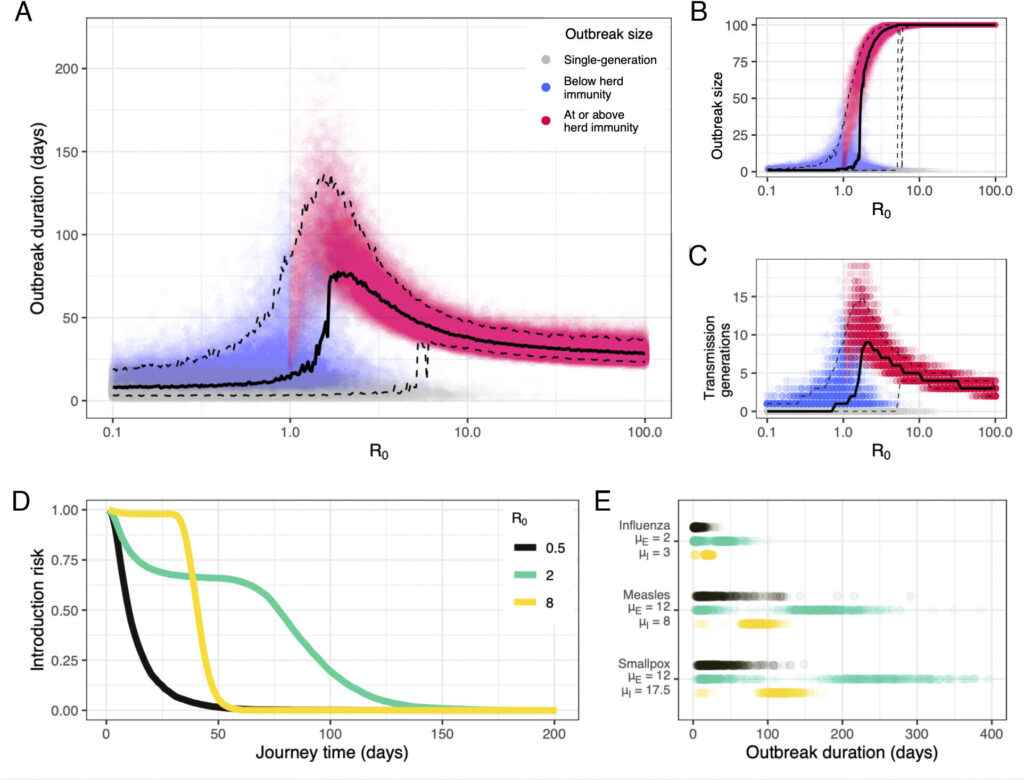Basic dynamics: (A) outbreak duration, (B) outbreak size, (C) number of infected generations, (D) probability that at least one person will be in state 𝐸 or state 𝐼 at any travel time (the “introduction risk”), and (E) distribution of outbreak lengths. Credit: Proceedings of the National Academy of Sciences (2024). DOI: 10.1073/pnas.2400425121
Two scientists at the University of California, Los Angeles have developed a way to estimate how quickly disease could have spread between distant places by sea hundreds of years ago.
In a study published in the Proceedings of the National Academy of Sciences, Elizabeth Blackmore and James Lloyd Smith outlined factors that could influence the spread of disease and mathematically applied them to the crew and passengers of transoceanic ships to learn more about disease spread in the early days of ocean travel.
Previous research has shown that the speed at which an infectious disease spreads varies greatly depending on factors such as the duration of infection and how easily the virus can be transmitted from host to host. The spread of a disease also depends heavily on the density and size of a particular population, and how many people are immune to the disease.
The impact of infectious diseases carried across the ocean by ship passengers and crew members is well documented — the introduction of smallpox to the New World, for example, is said to have devastated native populations — but researchers point out that there is little research to back up these claims.
In their study, they combined disease characteristics with mathematics to learn more about the true spread of diseases across oceans over the past few hundred years.
The researchers note that a ship’s role as a vector for disease could depend on a number of factors, including the disease itself. For example, influenza could have easily spread among sailors hundreds of years ago if a crew member had been infected when they boarded the ship. But early sailing ships took more than a month to cross the ocean, so the entire crew would have been infected and recovered by the time they reached the Americas.
Of course, other diseases would likely have different outcomes — measles, for example, has a 24% chance of remaining contagious after reaching a destination — and the researchers suggest that factors such as these likely led to infectious diseases spreading across the ocean more slowly and infrequently in the early days of maritime navigation.
The researchers also note that the introduction of steamships dramatically changed the situation, allowing for much faster sailing times and carrying more passengers. This would have dramatically increased the chances of disease being transmitted, the researchers say, as even a single sick passenger would have almost certainly spread the disease upon arrival at a distant destination.
Further information: Elizabeth N. Blackmore et al., “Transoceanic pathogen transmission in the era of sail and steam,” Proceedings of the National Academy of Sciences (2024). DOI: 10.1073/pnas.2400425121
© 2024 Science X Network
Citation: Mathematical model used to calculate disease spread rate during early ocean migration (July 23, 2024) Retrieved July 23, 2024 from https://phys.org/news/2024-07-mathematical-disease-early-ocean.html
This document is subject to copyright. It may not be reproduced without written permission, except for fair dealing for the purposes of personal study or research. The content is provided for informational purposes only.

